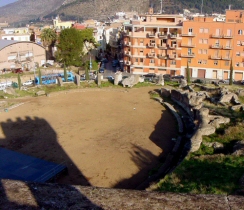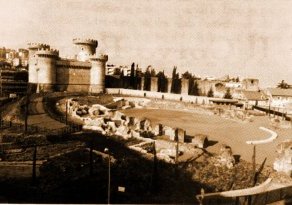Around the central arena of 61X41 m there is a passage 2,20 m wide covered with a barrel vault, near which there are wedge-shaped stones that supported the tier of seats disposed on an ellipse measuring externally 85X65 m. On the east side of the amphitheatre were inserted a paved street whose ruins are still visible. The conservation of this monument was difficult also because in the half of the XV century, the architects of Rocca Pia decided to destroy all the walls of the amphitheatre that exceeded the 3 m. of height. In fact, this fact could have allowed the enemies to hide between the ruins and to fill up with the materials of the castle all the sinkings surrounding area for the same reason.
The land of the amphitheatre
was turned into a park of hunting from the cardinal Ippolito
II d'Este, (or this reason, the name of Barchetto given
to the area). From the small park, the part near Rocca Pia
was excluded; here there were the holes, the drawbridge and
the only access road to the Rocca. Later, at the beginning
of 1600, the park passed to the cardinal Cesi, who turned
it into a garden and a part into forest.
The
first diggings have brought back to the light the single
Northern curve and now in the Southern part they are trying
to bring back to the light all the building, but it seems
really difficult since one of the four towers of the Rocca
Pia lies on the rests of the amphitheatre.
To the edges of the Barchetto, the stable of family d'Este rose. Later, "the STALLONE", with the casemate of the guard of the castle of Pio II, was turned into the characteristic "Taverna of the Rocca". As regards the dating of the amphitheatre, studying the construction techniques, we can state than it belongs to the Adrian age, as the Bleso's tombstone asserts. The external wall, the semicolumns leaned to the wedges, are constituted from parallelepipeds of tufa and head of travertin. Inside, the mixed work and the reticulated one prevail. The pavement was constituted from a mixture of mortar and crushed limestone. Probably, in the Southern part the amphitheatre was set in a tufaceous hill and therefore it would not have had need of substractions like instead in the Northern side. In the amphitheatre some finds of the Middle age and the modern one, have been found removing the earth that covered a part of the arena in 1991-92. Also six fragments of goblets and two matrices of the ceramics produced in Tivoli in the Roman age have been recovered. These fragments are now in the Roman National Museum together with the other found in 1927 in the adjacency of the amphitheatre. Today, the amphitheatre is used for the public manifestations, during parades, theatrical performances and concerts.






